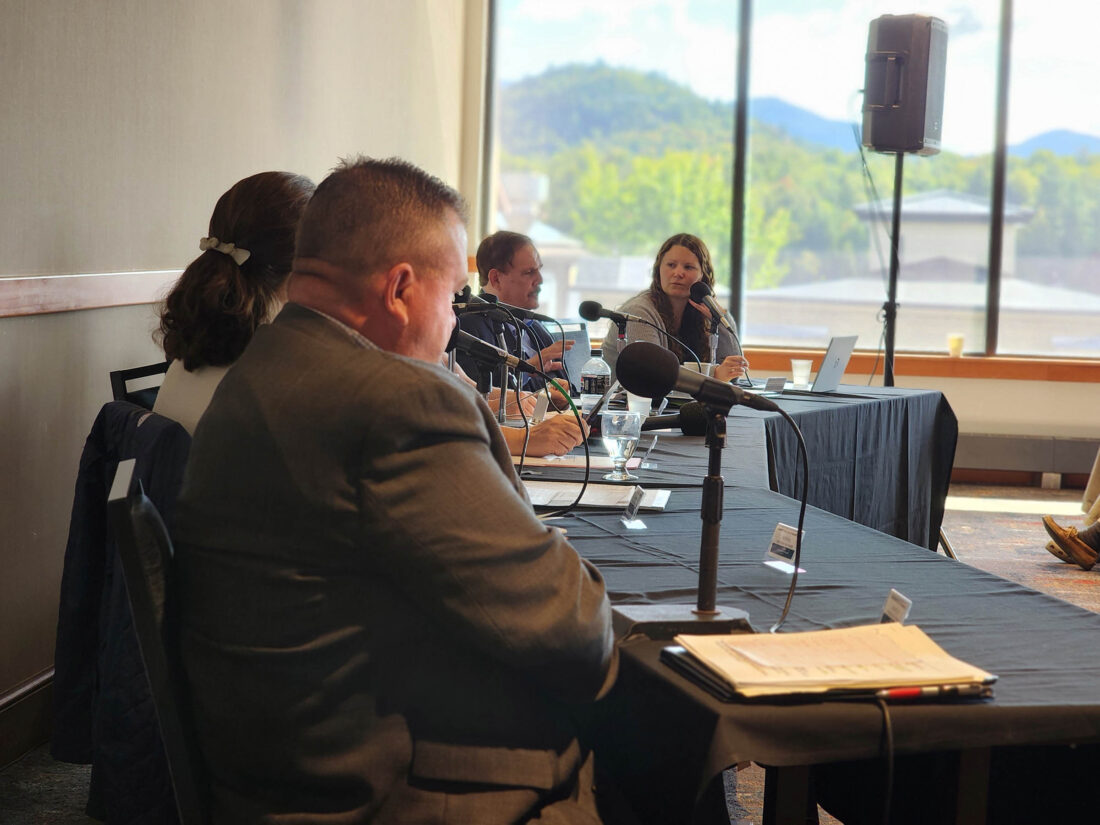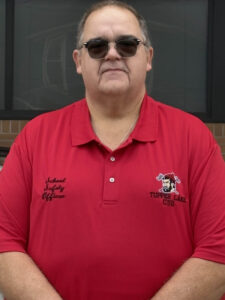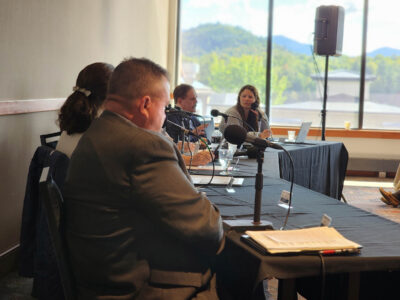Takeaways from NCPR, WAMC simulcast
Marks first collaboration between sister public radio stations

North Country leaders and business owners participate in the Adirondack Roundtable, hosted by NCPR and WAMC in a simultaneous broadcast at High Peaks Resort on Monday. The discussion centered on tourism and economic challenges facing the region. (Provided photo — Mitch Teich)
LAKE PLACID — North Country Public Radio and Albany-based WAMC hosted an “Adirondack Roundtable” discussion about tourism and the economy in the North Country during a first-of-its-kind collaboration between the two public radio stations on Monday.
Here are some key takeaways from the conversation.
–
The lack of Canadian visitors and business is real, and impactful
–
The first discussion focused on the social, political and economic relations between the North Country and Canada. Panelists included Garry Douglas, president of the North Country Chamber of Commerce, Neil Forkey, an associate professor and chair of the Canadian Studies Department at St. Lawrence University, Matthew Parrott, director of distribution for customs broker A.N. Deringer and Sarah Galvin, owner of The Bookstore Plus in Lake Placid.
Douglas reported that there is an ongoing concern about reduced tourism traffic and business from Canada. He cited figures showing that car crossings at the Canadian border near Plattsburgh are down 32%. The chamber conducted surveys of businesses in the border region and found a large dependency on Canadians — 13% of the hospitality businesses they surveyed get half of their business from Canadians, Douglas said.
Galvin noted that, anecdotally, there seemed to be fewer Canadian license plates on Main Street, especially earlier in the spring.
As a dual citizen and professor at an American university since the 1990s, Forkey offered a glimpse at the hurt that Canadians are feeling.
“Elbows are up, and that is a phrase that you hear from ordinary Canadians. You hear it from policy makers. You hear it from Prime Minister Mark Carney, at times,” he said. “Canadians are offended, mystified, disappointed and they’re staying home.”
He added that this phenomenon is affecting other states as well. He referenced a recent survey, which has been reported in numerous news outlets, showing that half of Canadian property owners in Florida are planning on selling their homes. AirCanada bookings to Las Vegas — popular for its NHL team, among other things — are down 30%, he said.
The discussion also posed a potential comparison to the last time border traffic was down, which was during the coronavirus pandemic. While some lessons may still be applicable — Galvin mentioned learning that individual relationships with guests and customers matter — the panel concluded that this time is distinctly different.
Douglas said the main difference is that now, people are choosing not to visit the North Country of their own volition. During the pandemic, the lapse was mostly due to strict restrictions.
“I think America and Canada felt like we were in the same boat (during the pandemic),” Parrott said. “We don’t feel like we’re in the same boat now, and we need to get back in the same boat. And that’s going to be tough right now.”
–
The US needs Canada, and vice versa
–
Despite concerns about Canada seeking out other trading partners, panelists agreed that Canada’s “number one” trading partner will always be the U.S. In contrast to the car traffic, Douglas said truck traffic at the border has remained relatively stable.
Parrott, speaking from a customs broker perspective, said the tariff situation has been very difficult to navigate. Traditionally, they provide the service of covering the tariff, or duty, for its customers.
“That is an untenable situation under the circumstances,” he said. “We had to talk to all of our customers and tell them, we can’t front your duty for you. You need to pay it yourself.”
Despite this, Parrott said some aspects of the U.S. and Canadian economies are simply impossible to separate — they’re really a big, combined economy, he said. The biggest example of this is car manufacturing. Another example is potash, a key fertilizer ingredient that is predominantly produced in Canada.
The panelists agreed that the relationship between the two countries will need to be repaired and continued.
“John F. Kennedy said long ago, ‘Geography has made his neighbors. History has made his friends. Economics has made his partners, and necessity has made his allies,'” Forkey said. “Those are still principles that tend to define the U.S.-Canada relationship.”
To listen to the rest of this conversation, visit tinyurl.com/ywe9kz86.
–
The North Country has needs, as well as opportunities
–
In a broader discussion of the economic needs and opportunities in the North Country, the second panel included Donna Beal, Mercy Care for the Adirondacks executive director; Franklin-Essex-Hamilton BOCES Superintendent Dale Breault; Katie Long, deputy director of the North Country Rural Development Coalition; and Tiffany Rea-Fisher, director of the Adirondack Diversity Initiative.
The discussion began around the decreased population in the Adirondacks, a trend that has been clear at least since the 2020 census. Breault spoke to the kinds of difficult decisions that the schools are facing as a result. He said taxpayers often ask why costs don’t go down along with enrollment, and said there isn’t always a linear relationship.
“If you have a physics teacher, you’re paying the same amount for that physics teacher whether there’s five students in the class or 20 students in the class,” he said. “‘Do we make the decision in the Adirondacks to no longer offer physics to our students?’ Those are the key questions that we’re dealing with.”
Breault said that some of the proposed solutions to lower enrollment include combining schools and districts. However, he said the geography of the region makes this largely unfeasible.
On the flip side, BOCES has seen an increase in enrollment in its career and technical education programs, with more than half of all juniors and seniors participating in them. Breault sees this as an opportunity and a sign of hope. The trend reflects some people thinking twice about a college education, but also means more workers entering industries such as health care and construction. A pipeline of these types of workers has the potential to help the region.
A major issue in the region is housing. NCPR reporter Emily Russell, who was moderating the conversation, cited Adirondack Park Agency figures that show only 55% of housing units in the park are occupied, compared to the state and national average of 90%.
This vacant housing is also comprised of short-term rentals, seasonal housing and vacant zombie properties, the likes of which are being addressed by initiatives like the Essex County Land Bank, Long said.
“When we look at vacant housing, it’s really important to remember that vacant does not mean available,” Long said.
She said an ideal solution would involve converting some of the STRs into long-term rental opportunities. In general, some of the major hurdles to developing new housing or rehabilitating old housing is cost and availability of contractors.
“Even when we can find contractors, one of the issues is — ‘why would they invest in these rehab properties, when they could be building multi-million dollar lake homes that would better support their financial situation?'” Long said.
To listen to this full conversation, visit tinyurl.com/mry9my6t.



